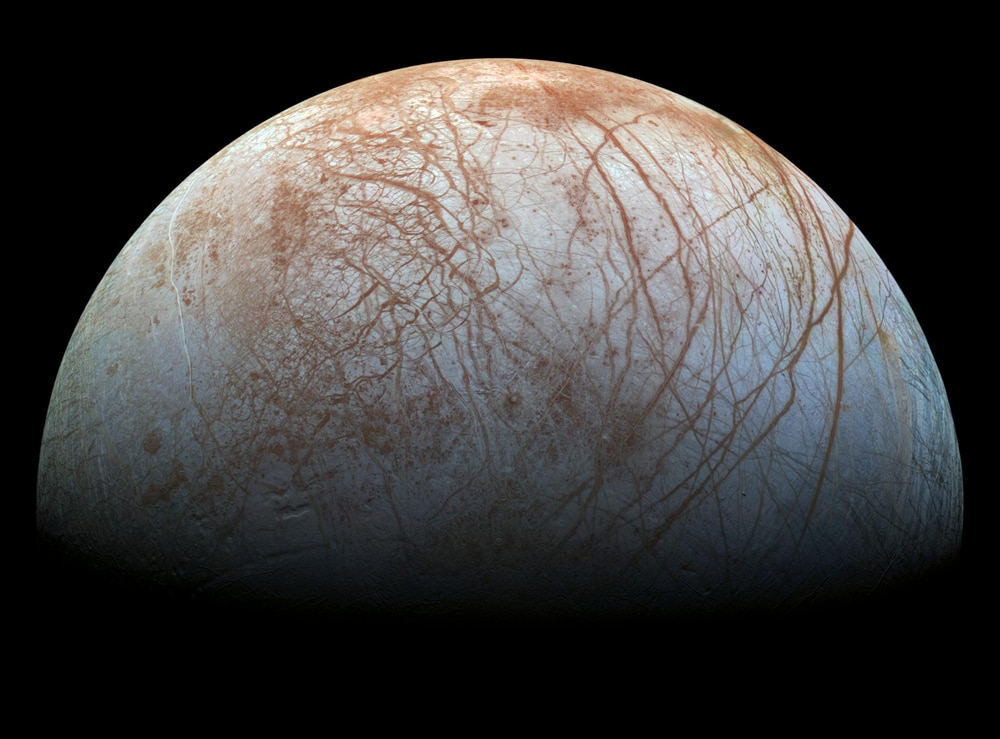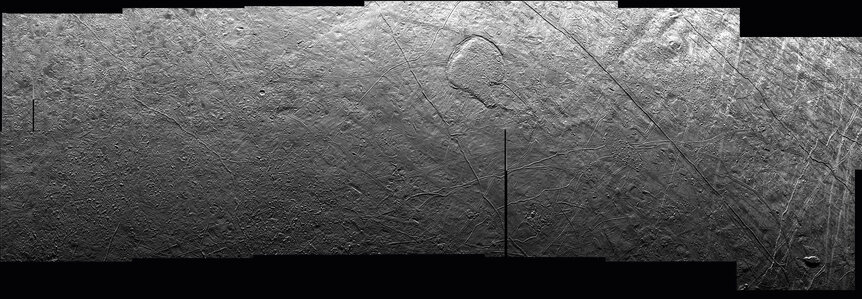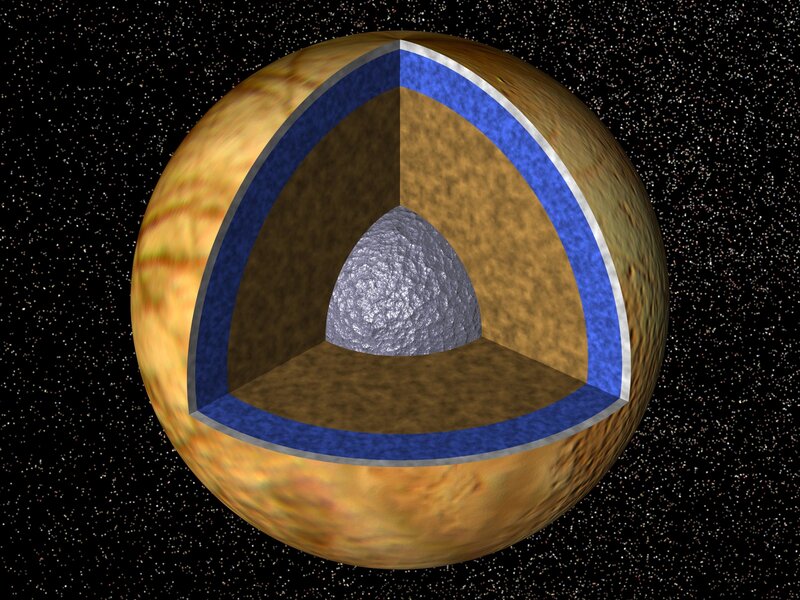Create a free profile to get unlimited access to exclusive videos, sweepstakes, and more!
The salty ocean of Europa: Table salt found on Jupiter's moon

If you're hoping to find life elsewhere in the solar system, where do you look? Surprisingly, some of the more clement places in space are icy moons of the giant planets. That might seem weird at first, since these are small, atmosphereless, extremely frigid objects. But we've built up a huge amount of evidence that they have liquid water oceans under their surfaces — in the case of Saturn's Enceladus, geysers erupting from the moon's south pole make that obvious!
But Jupiter's moon Europa is the original. It was postulated in the 1970s, and more recently confirmed, that it has a liquid water ocean under the frozen surface, heated by Jupiter's gravity; its orbit is slightly elliptical, so the gravity it feels from Jupiter changes during its orbit. This makes it flex, creating internal friction, which in turn creates heat… enough to melt the ice and create an ocean perhaps a hundred kilometers deep.
That makes life an interesting possibility. But it depends on the ocean chemistry as well. And that brings us to a fascinating new result about Europa: Astronomers have found evidence of what looks like sodium chloride on the surface of the moon. That's table salt! And the implications of that when it comes to life are interesting indeed.
The surface of Europa is mostly white water ice. But there's evidence of salt on the surface as well. When a chemist says "salt" they mean it generically as a compound left over when an acid reacts with a base. There are lots of different kinds, depending on the acids and bases that reacted. Table salt is sodium chloride, abundant in Earth's oceans. There's also magnesium chloride, for example, and others that are called sulfates.
The Galileo spacecraft flew around the Jupiter system for over seven years, and detected something on the surface of Europa that was assumed to be some sort of sulfate, probably from the undersurface ocean. Cracks in the surface ice allow briny water to get to the surface where it rapidly evaporates, leaving behind salts on the surface (if you've ever seen a blindingly white dry lake bed in the summer then you have an idea how that works; the white is from salts deposited as the water evaporated).
And, in fact, more recent observations indicated the presence of magnesium sulfate on Europa… but interestingly only in the trailing hemisphere. Tides from Jupiter have caused Europa to spin once every orbit, meaning it keeps the same face toward Jupiter (just like our own Moon keeps the same face toward us). That in turn means that one hemisphere always faces into the direction of Europa's orbit — the leading hemisphere — and the other faces behind — the trailing hemisphere.
Jupiter's magnetic field is immensely powerful, and traps lots of subatomic particles and atomic nuclei in its field lines. As Jupiter rotates, it whips these particles through space, which then slam into the trailing hemispheres of the moons (Jupiter rotates much more rapidly than the moons orbit, so the particles catch up to the moons and hit them in the back). The magnesium sulfate detected by Galileo was on the trailing hemisphere, so it seems likely that it was in part created by that radiation bombardment of other molecules. In fact, regions on Europa that are known to have materials that seeped up from the interior, but are protected from the radiation, don’t show signs of magnesium sulfate. That implies that the radiation is what created it, and it’s not coming natively from the ocean.
Here's where the fun starts. On the leading hemisphere there are regions called chaos terrain; there are ridges and cracks, and the flatter parts appear to have segments that overlap with each other. This is likely due to upwelling from the ocean underneath, which jumbles up the otherwise orderly terrain. If you want to know what's in the ocean, that's a good place to look.
Different elements and molecules absorb light at different colors. You can look for specific things by taking spectra of that object, breaking the light up into hundreds or thousands of individual colors. If some colors are missing, that's like a fingerprint of certain molecules. That's usually done in the near infrared (just outside what our eyes can see) for planetary surfaces. But spectra like that of Europa are relatively featureless. That doesn't help ID anything there — but it does mean there isn't much or any magnesium sulfate there (if there were, it would be obvious in the spectra).
So assuming there is some salt there, what kind would it be? That's when the astronomers involved (full disclosure: One of them is my old friend Mike Brown — who has a thread on Twitter explaining these observations — and another is Kevin Hand, with whom I've done panels at Comic-Con) got a flash of insight: What if the sodium chloride changed colors when bombarded with radiation? That might make it detectable!
They went to a lab and zapped table salt with the kind of radiation Europa experiences… and the salt turned yellow. Hmmmmm. It turns out the radiation affects the crystal structure of sodium chloride, making it appear yellow rather than white.
So a third member of their team, Samantha Trumbo, got time on Hubble Space Telescope to take spectra of Europa in visible light*, which includes the color they saw in the lab. And what they found is amazing: The spectra clearly showed a feature exactly where the lab results predicted! (If you're curious, it was centered at 450 nanometers, and showed that blue and green light were being absorbed — meaning whatever was there would look yellow by eye).
Moreover, the locations on Europa where they found this feature were in the chaos regions on the leading hemisphere! That is exactly what you'd expect from water seeping up from inside the moon.
Whoa. While this isn't 100% confirmed, it does seem very likely that they have found the presence of sodium chloride on Europa. And that means the water in the subsurface ocean is similar to Earth's.
It's actually difficult to produce water with lots of table salt in it unless there are geologically interesting things happening deep below the surface. Europa likely has a solid rocky core under the ocean; salt from the core can then bubble up from hydrothermal vents on the ocean floor. These are cracks in the floor where heat from below seeps upward, and we see lots of them on Earth. They are a great place to look for life, because they provide an energy source as well as chemicals life needs. These vents on Earth are teeming with life.
So you can see why this is a very interesting finding. We can't say for sure yet if Europa has life on it… or more accurately under its surface. But the case for it being possible just got a wee bit stronger. I'll note, too, that Europa has more water under its surface than Earth does in all its oceans.
And as I write this in mid-June 2019, Jupiter has reached opposition, when it's opposite the Sun in Earth's sky. That means it rises at sunset and is visible all night. It also means it's as close to Earth as it will be for the next 13 months or so, making now the ideal time to go out and see it. To the eye it looks like an extremely bright star, but with binoculars four tiny sparks can be seen aligned near it. Those are the four biggest moons, called the Galilean Moons. One of them is Europa. If you have a pair of binocs or a small 'scope (or have an astronomy club nearby), I urge you to take a look.
Are there little beasties swimming in the oceans of that tiny dot of light, under a shell of ice 10 kilometers thick? The best we can say is "maybe," but it seems like that word is getting a little bit more interesting every time we look harder at Europa.
*They used STIS, the Space Telescope Imaging Spectrograph, which I immodestly note I worked on before and after it was launched into space and placed onboard Hubble. I'm biased, certainly, but it's always fun to point out when that old workhorse gets used for cutting-edge science.
















